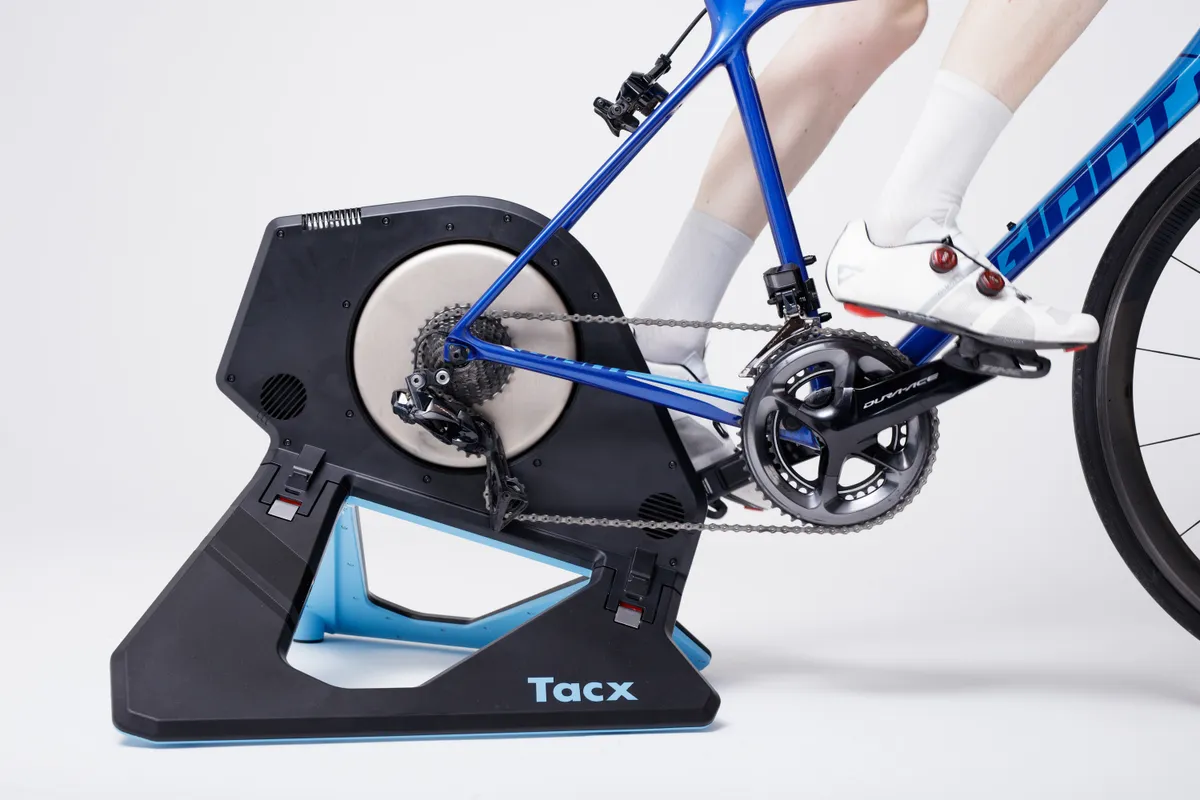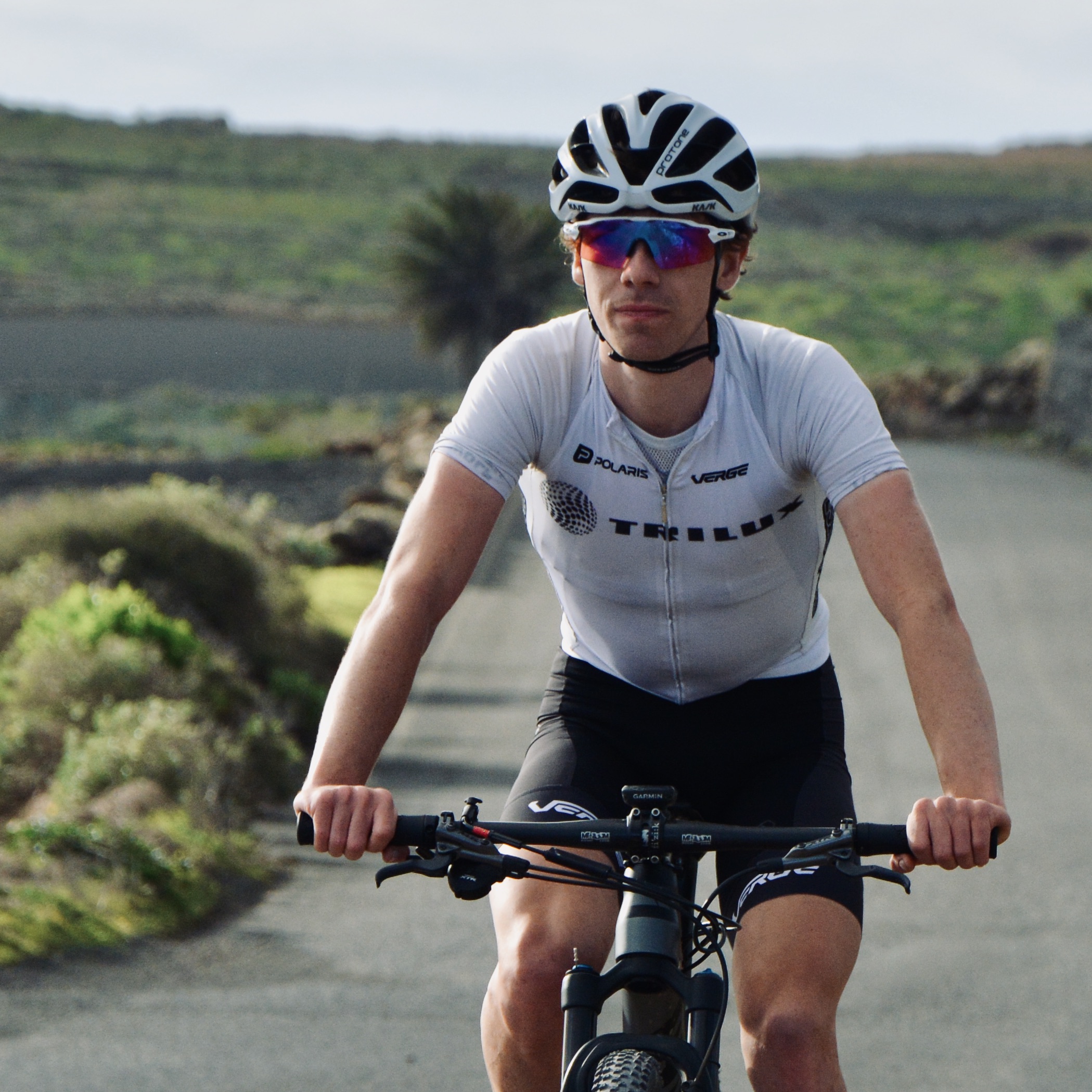Power-to-weight ratio is one of the key metrics that determines how quickly a cyclist can climb uphill.
Of course, the total power output you can produce plays a role in determining your overall cycling performance, but raw wattage alone doesn’t always tell the entire story, especially when climbing hills comes into the equation.
This is where your power-to-weight ratio – expressed as watts-per-kilogram – is key.
Normalising your power output to your body weight can provide a better means of assessing your ability over hilly terrain and comparing your performance to other cyclists.
Here, we’ll look at how to calculate your own power-to-weight ratio, how to improve it and what effect that improvement can have on your cycling performance.
Calculating power-to-weight ratio
Your power-to-weight ratio can be calculated as watts (W) divided by your body weight in kilograms (kg), expressed as W/kg.
All you need to do is take the power output you can sustain for a given duration or at a certain physiological threshold (we’ll come on to that) and divide it by your body weight in kilograms to find your own W/kg.
The watts used in this calculation will most commonly refer to your power output at your maximal steady-state power, which could be an identified lactate concentration (e.g. 4 mmol/L), critical power or, most commonly, Functional Threshold Power (FTP).
For example, if you complete an FTP test and your Functional Threshold Power is determined to be 250 watts, and you weigh 75kg, your power-to-weight ratio here will be 3.33 W/kg.

While lactate concentration, critical power and FTP are slightly different from one another, they are all essentially trying to identify a maximal point at which exercise intensity can be maintained without the rapid onset of fatigue.
At the same time, your W/kg over shorter and longer durations can just as easily be calculated to see how you stack up in other types of effort – for example, on a single hill, or over the course of an entire event or ride.
Other common durations of comparison include your W/kg over one minute (roughly indicating your anaerobic capacity) and five minutes (roughly indicating your aerobic capacity, or VO2 max).
Why does W/kg matter?

As mentioned above, your power-to-weight ratio really starts to affect performance when climbing comes into the picture.
That’s because, when climbing, the dominant source of resistance to your forward motion is gravity.
The gravitational force you have to overcome is dependent on your body weight. So producing 300W as a 60kg person (5 W/kg) will get you up the hill faster than producing 300W as a 90kg person (3.3 W/kg).
In contrast, when riding on the flat, the dominant source of resistance to your forward motion is air resistance. This increases with speed and also depends on your frontal area (i.e. how big you are).
In this case, body weight has a small indirect impact, because bigger people are often heavier. But this impact is much less than for climbing and, ultimately, it’s usually raw power that makes the difference on the flat rather than W/kg.

A cyclist’s power-to-weight ratio isn’t just a relevant metric for riders who want to climb faster in the real world.
The virtual roads and trails found on indoor cycling apps, such as Zwift, RGT Cycling and Rouvy, use your W/kg as a major determinant in how fast you go, and thus having a good W/kg can help you win Zwift races and stay up at the front in virtual group rides on hilly courses.
Zwift also uses W/kg to categorise races and group rides, so you can find a group to match your ability.
What’s a good power-to-weight ratio?

Now that you have some idea about how your power-to-weight can affect performance, what do good numbers actually look like for different ability levels?
A power profile chart is commonly used to compare different ability categories in terms of power-to-weight ratio.
Power-to-weight ratio chart
| | Male | Female | ||||||
|---|---|---|---|---|---|---|---|---|
| 5-sec | 1-min | 5-min | FTP | 5-sec | 1-min | 5-min | FTP | |
| World class | 25.2 | 11.5 | 7.6 | 6.6 | 19.4 | 9.3 | 6.7 | 5.7 |
| 24.9 | 11.4 | 7.5 | 6.5 | 19.2 | 9.2 | 6.6 | 5.6 | |
| 24.6 | 11.3 | 7.4 | 6.4 | 19 | 9.1 | 6.5 | 5.5 | |
| 24.3 | 11.1 | 7.3 | 6.3 | 18.8 | 9 | 6.4 | 5.4 | |
| 24 | 11 | 7.2 | 6.2 | 18.5 | 8.9 | 6.4 | 5.4 | |
| 23.7 | 10.9 | 7.1 | 6.1 | 18.3 | 8.8 | 6.3 | 5.3 | |
| 23.4 | 10.8 | 7 | 6 | 18.1 | 8.7 | 6.2 | 5.2 | |
| 23.1 | 10.7 | 6.9 | 5.9 | 17.9 | 8.6 | 6.1 | 5.1 | |
| Exceptional | 22.8 | 10.6 | 6.8 | 5.8 | 17.7 | 8.5 | 6 | 5 |
| 22.5 | 10.4 | 6.6 | 5.7 | 17.4 | 8.5 | 5.9 | 4.9 | |
| 22.2 | 10.3 | 6.5 | 5.6 | 17.2 | 8.4 | 5.8 | 4.9 | |
| 21.9 | 10.2 | 6.4 | 5.6 | 17 | 8.3 | 5.7 | 4.8 | |
| 21.5 | 10.1 | 6.3 | 5.5 | 16.8 | 8.2 | 5.6 | 4.7 | |
| 21.2 | 10 | 6.2 | 5.4 | 16.6 | 8.1 | 5.5 | 4.6 | |
| Excellent | 20.9 | 9.9 | 6.1 | 5.3 | 16.3 | 8 | 5.4 | 4.5 |
| 20.6 | 9.7 | 6 | 5.2 | 16.1 | 7.9 | 5.3 | 4.4 | |
| 20.3 | 9.6 | 5.9 | 5.1 | 15.9 | 7.8 | 5.2 | 4.3 | |
| 20 | 9.5 | 5.8 | 5 | 15.7 | 7.7 | 5.1 | 4.3 | |
| 19.7 | 9.4 | 5.7 | 4.9 | 15.5 | 7.6 | 5 | 4.2 | |
| 19.4 | 9.3 | 5.6 | 4.8 | 15.2 | 7.5 | 4.9 | 4.1 | |
| Very good | 19.1 | 9.2 | 5.5 | 4.7 | 15 | 7.4 | 4.8 | 4 |
| 18.8 | 9 | 5.4 | 4.6 | 14.8 | 7.3 | 4.7 | 3.9 | |
| 18.5 | 8.9 | 5.3 | 4.5 | 14.6 | 7.3 | 4.6 | 3.8 | |
| 18.2 | 8.8 | 5.2 | 4.4 | 14.4 | 7.2 | 4.5 | 3.8 | |
| 17.9 | 8.7 | 5.1 | 4.3 | 14.1 | 7.1 | 4.4 | 3.7 | |
| 17.6 | 8.6 | 5 | 4.2 | 13.9 | 7 | 4.3 | 3.6 | |
| Good | 17.3 | 8.4 | 4.9 | 4.1 | 13.7 | 6.9 | 4.2 | 3.5 |
| 17 | 8.3 | 4.7 | 4 | 13.5 | 6.8 | 4.1 | 3.4 | |
| 16.7 | 8.2 | 4.6 | 3.9 | 13.3 | 6.7 | 4 | 3.3 | |
| 16.4 | 8.1 | 4.5 | 3.8 | 13 | 6.6 | 3.9 | 3.3 | |
| 16.1 | 8 | 4.4 | 3.7 | 12.8 | 6.5 | 3.8 | 3.2 | |
| 15.8 | 7.9 | 4.3 | 3.6 | 12.6 | 6.4 | 3.7 | 3.1 | |
| Moderate | 15.5 | 7.7 | 4.2 | 3.6 | 12.4 | 6.3 | 3.6 | 3 |
| 15.2 | 7.6 | 4.1 | 3.5 | 12.2 | 6.2 | 3.5 | 2.9 | |
| 14.9 | 7.5 | 4 | 3.4 | 11.9 | 6.1 | 3.4 | 2.8 | |
| 14.6 | 7.4 | 3.9 | 3.3 | 11.7 | 6 | 3.3 | 2.8 | |
| 14.3 | 7.3 | 3.8 | 3.2 | 11.5 | 6 | 3.2 | 2.7 | |
| 14 | 7.2 | 3.7 | 3.1 | 11.3 | 5.9 | 3.1 | 2.6 | |
| Fair | 13.7 | 7 | 3.6 | 3 | 11.1 | 5.8 | 3 | 2.5 |
| 13.4 | 6.9 | 3.5 | 2.9 | 10.8 | 5.7 | 2.9 | 2.4 | |
| 13.1 | 6.8 | 3.4 | 2.8 | 10.6 | 5.6 | 2.8 | 2.3 | |
| 12.8 | 6.7 | 3.3 | 2.7 | 10.4 | 5.5 | 2.7 | 2.2 | |
| 12.5 | 6.6 | 3.2 | 2.6 | 10.2 | 5.4 | 2.6 | 2.1 | |
| 12.2 | 6.5 | 3.1 | 2.5 | 10 | 5.3 | 2.6 | 2.1 | |
| Novice 2 | 11.9 | 6.3 | 3 | 2.4 | 9.7 | 5.2 | 2.5 | 2 |
| 11.6 | 6.2 | 2.8 | 2.3 | 9.5 | 5.1 | 2.4 | 1.9 | |
| 11.3 | 6.1 | 2.7 | 2.2 | 9.3 | 5 | 2.3 | 1.8 | |
| 11 | 6 | 2.6 | 2.1 | 9.1 | 4.9 | 2.2 | 1.7 | |
| 10.7 | 5.9 | 2.5 | 2 | 8.8 | 4.8 | 2.1 | 1.7 | |
| 10.4 | 5.7 | 2.4 | 1.9 | 8.6 | 4.8 | 2 | 1.6 | |
| Novice 1 | 10 | 5.6 | 2.3 | 1.8 | 8.4 | 4.7 | 1.9 | 1.5 |
| 9.7 | 5.5 | 2.2 | 1.7 | 8.2 | 4.6 | 1.8 | 1.4 | |
| 9.4 | 5.4 | 2.1 | 1.6 | 8 | 4.5 | 1.7 | 1.3 | |
| 9.1 | 5.3 | 2 | 1.6 | 7.7 | 4.4 | 1.6 | 1.2 | |
| 8.8 | 5.2 | 1.9 | 1.5 | 7.5 | 4.3 | 1.5 | 1.2 | |
| 8.5 | 5 | 1.8 | 1.4 | 7.3 | 4.2 | 1.4 | 1.1 | |
| 8.2 | 4.9 | 1.7 | 1.3 | 7.1 | 4.1 | 1.3 | 1 |
(Values shown are in W/kg. Adapted from Allen & Cooper et al. 2010)
Your W/kg across the different durations can give some insights into where you are most/least naturally talented or where you need to improve to achieve your goals. You can then use this information to create a training plan.
However, it’s worth noting that you’re unlikely to excel across all durations.
An FTP of more than 6 W/kg is commonly associated with professional cyclists who specialise in climbing. However, these cyclists often have weaker 5-sec and 1-min W/kg values compared to sprinters, due to their muscles being heavily adapted to aerobic metabolism.
Similarly, these sprinters will have lower W/kg ratios at their FTP due to factors such as greater muscle mass and larger anaerobic capacities.
Ultimately, a W/kg chart like this can give you a good idea of how you stack up against other cyclists, what durations you’re most suited to and where you might want to focus your training.
How to improve your power-to-weight ratio

When looking to improve your power-to-weight ratio, perhaps with the goal of becoming a faster climber on the bike, this can be achieved by increasing your power output, lowering your body weight or ideally accomplishing both at the same time.
Reducing your body weight is ideally achieved by reducing body fat (rather than muscle), which can be done by ensuring you have a small energy deficit between what you eat and how much you burn, and following a diet that allows you to do this over the long-term.
In general, diets that help achieve this are relatively high in protein (e.g. between 1 to 1.5g/kg of body weight), fruit, vegetables and wholegrains.
These foods are filling but also relatively light in calories, and the moderately high protein intake can also help conserve your muscle mass during weight loss.
If you’re training quite a lot, you’ll also want to make sure you’re getting in a good proportion of carbohydrates in order to fuel high-intensity workouts and support your immune system (between 6 and 10g/kg of body weight depending on training volume).
Training to improve power output will differ depending on the duration you’re targeting (e.g. W/kg over one minute versus W/kg over one hour). However, many cyclists aim to improve their W/kg at their maximal steady-state power (e.g. FTP).
Training to improve your power at your maximum steady-state is best achieved through:
- Long, low-intensity base training rides at around 55 to 75 per cent FTP or 68 to 83 per cent threshold heart rate (useful if you're using training zones), which helps reduce lactate production and improve lactate clearance.
- Intervals at around your threshold power or heart rate, which help improve your ability to clear lactate. We particularly like intervals that alternate between intensities just above and just below your threshold.
- Intervals that allow you to elevate your heart rate close to maximum and hold it there for several minutes, helping to develop your aerobic capacity, which impacts how much lactate you produce and clear. We particularly like intervals that start hard (e.g. 120 to 130 per cent FTP or 8 to 9/10 effort) for a few minutes. Then you can adjust your intensity to whatever is required to hold your heart rate above 90 per cent max for a further four to six minutes.
